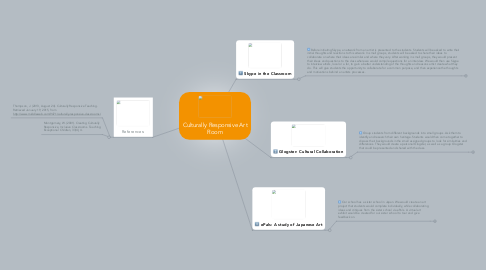Culturally Responsive Art Room
by Angie Hall


1. Skype in the Classroom
1.1. Before initiating Skype, an artwork from an artist is presented to the students. Students will be asked to write their initial thoughts and reactions to this artwork. In small groups, students will be asked to share their ideas to collaborate on where their ideas are similar and where they vary. After working in small groups, they would present their ideas and questions to the class where we would compile questions for an interview. We would then use Skype to interview artists, local or a far, to gain a better understanding of the thoughts and reasons artist create what they do. This will give students the opportunity to collaborate for a common purpose, and then experience the thoughts and motivations behind an artists processes.
1.1.1. Recruit Project Sponsor
1.1.2. Recruit Project Manager
1.1.3. Review Related Projects and Lessons Learned
1.1.4. Prepare Project Initiation Plan
1.1.5. Brief the Initial Project Team
1.1.6. Review Project Kick-off Plans and Presentation Map
1.1.7. Hold Project Kick-off Meeting
2. Glogster: Cultural Collaboration
2.1. Group students from different backgrounds into small groups. Ask them to identify and research their own heritage. Students would then come together to discuss their backgrounds in the small assigned groups to look for similarities and differences. They would create a personal Glogster, as well as a group Glogster that could be presented and shared with the class.
2.1.1. Establish checkpoints
2.1.2. Acquire team resources for stage
2.1.3. Conduct stage kick-off meeting
3. ePals: A study of Japanese Art
3.1. Our school has a sister school in Japan. We would create an art project that students would complete individually, while collaborating ideas and critiques from the sister school via ePals. A virtual art exhibit would be created for our sister school to tour and give feedback on.
3.1.1. Prepare Product Evaluation
3.1.2. Conduct Product Evaluation
3.1.3. Initiate Maintenance Process
